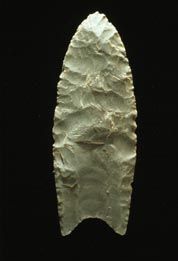
New research in Texas shows humans settled North America earlier than previously thought.
Summit County -- New archaeological research in Texas suggests that humans lived in North America thousands of years earlier than previously believed.
For about 100 years, archaeologists have dated the earliest human artifacts to the Clovis people, about 13,000 years ago. The new finds push this date back by about 2,500 years, into the pre-Clovis era, according to a press release from Baylor University.
"This find really rewrites history, so to speak, and changes our collective thought on the early colonization of North, Central and South America," said Dr. Lee Nordt, professor of geology at Baylor and dean of the College of Arts and Sciences, who is an author on the study. "What sets this study a part is that we were able to show using geological methods that the buried artifacts dating to pre-Clovis times were in their original state. This demonstrates unequivocally that the peopling of the Americas occurred much earlier than previously thought."
The study appears in the April issue of the journal
Science.
At the Debra L. Friedkin archeological site, located about 10 miles outside of Salado in Central Texas, the Baylor researchers, along with their colleagues, found nearly 16,000 artifacts that predated the Clovis people. Most the artifacts were chipping debris from the making and reshaping of tools, however, about 50 artifacts were tools themselves such as knives and projectile points. The dating process placed these artifacts back to about 15,500 years ago. This find is not only the earliest evidence of human occupation in North, South and Central America, it also has the largest number of artifacts dating to the pre-Clovis time period.
Nordt and Dr. Steve Driese, professor and chair of geology at Baylor, College of Arts and Sciences, collected samples from the site and analyzed particle-size distribution, organic carbon and calcium carbonate content. The systematic depth functions of these properties demonstrated to the Baylor researchers that the mixing process from the dirt shifting or cracking was not a factor in the formation of the archaeological site. Their analysis proved that the site was undisturbed and that the artifacts were in place since they were discarded 15,500 years ago.
"There is absolutely no evidence that there was erosion or soil movement when the site was formed that could have significantly redistributed the archaeological materials," Driese said. "This was really a critical finding. There have been several credible sites in North and South America which date older than the Clovis people, but the evidence is not real strong. This study proves people inhabited the Americas earlier than previously believed."
The Baylor researchers also said more than 60 "optically-stimulated luminescence dates" show that the early people arrived at the site by about 15,500 years ago. The luminescence dating technique is a method used to date the sediment surrounding the artifacts by dating the last time the sediment was exposed to sunlight.
The Baylor researchers said the artifacts show an array of different technologies and there is no doubt that the tools and weapons were human-made, dating to about 15,500 years ago. Analysis of the Debra L. Friedkin archeological site is ongoing and future studies will help explain where these people came from, how they adapted to the new environments and understand the origins of later groups like the Clovis people.
Reader Comments
to our Newsletter